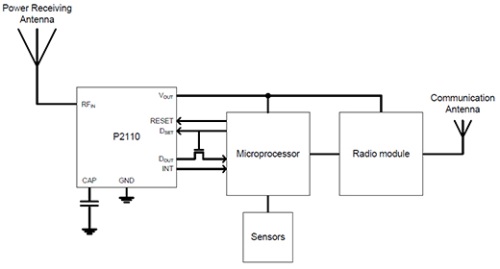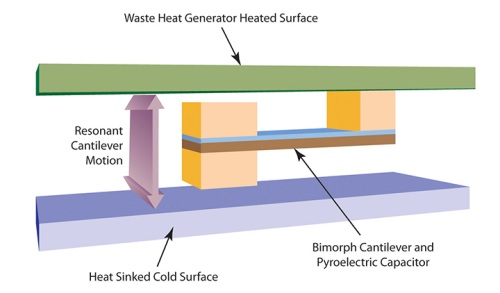As mobile phones morphed from wireless analog telephones to handheld computers, users kept demanding more and more energy-consuming features, such as web browsing, videos, gaming, and email, while still requiring extended battery life. Since battery makers were not much help, semiconductor manufacturers devised numerous energy-saving techniques to make it all possible. They have been wildly successful.
Low power has been the most important electronic design criterion for at least the last ten years. Thanks to Moore’s Law and a lot of smart engineers, semiconductor power levels have dropped dramatically, often consuming milliwatts in run mode and nanowatts in standby mode. As a direct result, ultra-low-power wireless sensorless networks finally became possible and their adoption has been dramatic. Now, sensors stand alone in remote or hard-to-reach areas to warn of building and bridge stresses, air pollution, forest fires, pending landslides, worn bearings, and wing vibration. Low-power wireless sensor networks are at the heart of numerous industrial, medical, and commercial applications.
However, off-grid, as well as portable sensor nodes, rely on batteries for power and face the same problem as cell phones. In such cases, it is advisable to prolong battery life by harvesting environmental energy sources – most often available as light, heat, vibration, motion, or ambient RF. If a device’s energy requirement is low enough and battery replacement would be difficult or expensive, it may be possible to dispense with the battery altogether and rely exclusively on harvesting ambient energy sources for power. The combination of ultra-low-power MCUs and energy harvesting have given rise to a wealth of applications that previously were not possible.
The energy harvesting market is large and growing rapidly. According to analysts at IDTechEx, energy harvesting was a $0.7 billion market in 2012 and is expected to exceed $5 billion by 2022; by then 250 million sensors will be powered by energy harvesting sources. The market for thermoelectric energy harvesting alone will reach $865 million by 2023.
Current technologies and applications
There are several energy harvesting technologies in common use, with some innovative techniques just over the horizon. The most common energy sources are light, heat, vibration, and RF. Short of rooftop solar panels none of them generate a great deal of energy (see Figure 1), but one or more of them may be more than adequate to power low-power devices in a particular environment.

Figure 1: Power available from energy harvesting sources.
Solar
There is hardly a home or office that does not have at least one solar-powered calculator – actually, a calculator with a coin-cell battery and a small front panel photovoltaic (PV) cell to top it up. These polycrystalline silicon or thin-film cells convert photons to electrons with a typical efficiency of about 15 to 20% for polycrystalline and 6 to 12% for thin film cells. Since the power available from indoor lighting is typically only about 10 µW/cm², their usefulness depends on the size of the module plus the spectral composition of the light.
Small solar cells are frequently used in consumer and industrial applications, including toys, watches, calculators, street lighting controls, portable power supplies, and satellites. Since light sources tend to be intermittent, solar cells are used to charge batteries and/or supercapacitors to provide a stable energy source.
Thermoelectric
Thermoelectric harvesters exploit the Seebeck effect, where a voltage is created when a temperature differential exists at the junction of two dissimilar metals. Thermoelectric generators (TEGs) consist of an array of these thermocouples connected together in series to a common heat source such as an engine, water heater, or even the back of a solar panel. Output depends on the size of the TEG and the temperature differential that can be maintained. TEGs are typically used to power wireless sensor nodes in high-temperature environments such as industrial heating systems. A TEG mounted between a power transistor and its heatsink can recycle some of the energy that would otherwise be lost as heat.
Micropelt’s TE-CORE7 Thermal Energy Harvesting Modules convert locally available waste heat to provide long-life operation for low-power devices. The TE-CORE TEG converts heat to an electrical charge which is then boosted, stored in a 100µF capacitor, and regulated to supply up to 5.5V. Running at 50°C the TE-CORE7 can deliver 6.424mAh annually, the equivalent of three to four AA batteries – at that rate the batteries would need to be changed every few months.
Forcing a current to flow through the junction of dissimilar metals will cause heat to transfer from the hot to the cool junction – the Peltier effect, essentially the opposite of the Seebeck effect. The Peltier effect is the basis for thermoelectric heat pumps.
Piezoelectric
Piezoelectric transducers generate electricity when stressed, which make them good candidates for vibration sensors when they are used in energy harvesting modules that detect motor bearing noise and the vibration of aircraft wings. The Midé Volture™ V-20W Vibration Energy Harvester employs a cantilever that attaches to a piezoelectric crystal. When vibrations set the cantilever in motion it generates an AC output voltage that is rectified, regulated, and stored in a supercapacitor or thin-film battery.

Figure 2: Midé Volture™ piezoelectric energy harvester (Courtesy of Midé).
Radio Frequency – RF
RFID works by rectifying a strong local signal (not ambient RF) aimed directly at the sensor. Similarly Powercast’s P2110 RF Powerharvester™ receiver converts low-frequency RF signals to 5.25V, providing up to 50mA output current. In conjunction with a low-power MCU, sensors, and a radio module, the P2110 can provide a complete, battery-free wireless sensor node that can operate with as little as -11.5dBm RF input. Applications for the device include battery-free wireless sensors for industrial monitoring, building automation, smart grid, agriculture, and defense applications. Mouser carries Powercast development kits for battery charging and wireless sensors.

Figure 3: Powercast P2110 in a batteryless wireless sensor (Courtesy of Powercast).
Innovative techniques and technologies
Some very interesting energy harvesting technologies that are still in the laboratory could change the face of the energy harvesting industry over the next few years.
Medical and Fitness Devices
Some novel uses for piezoelectric energy harvesting are starting to emerge. Researchers at the University of Michigan have developed a device that harvests energy from the reverberation of heartbeats through the chest and converts it to electricity to run a pacemaker or an implanted defibrillator, hopefully obviating the need for periodic battery replacement. Research is also under way looking for ways to scavenge body heat, movement, and vibration to power other implantable devices.
RF is already being used experimentally to recharge the batteries in pacemakers and implanted transcutaneous electrical nerve stimulation (TENS) devices. The patient sits in a chair that contains a low-frequency RF source whose output is received, rectified, and stored by the device.
Researchers at MIT and Harvard have developed a chip that can be implanted into the inner ear, with power provided by harvesting the energy in sound waves. The chip is designed to monitor biological activity in the ears of people with hearing or balance impairments.
Fitness buffs will be happy to learn that they can recapture some of the energy they expend at the gym. Three British universities have teamed up to develop a piezoelectric energy harvesting device that attaches to the knee, generating power as they walk or run on the treadmill. Riga Technical University offers a mechanical energy harvester that requires magnets to be sewn into the sleeves and coils into the pockets of a jacket; swinging the arms past the pockets while walking generates a current that can be stored in a battery. Anything to keep that iPhone charged!
MEMS pyroelectric generator
Oak Ridge National Laboratories has developed a unique pyroelectric generator that can cool electronic devices, photocells, computers, and even large waste-heat producing systems while generating electricity. The device is based on a MEMS pyroelectric capacitor at the end of a bimetal cantilever that oscillates between hot and cold surfaces. The tip of the hot cantilever comes into contact with a cold surface, the heat sink, where it rapidly loses its heat and causes the cantilever to move back and make contact with the hot surface. The oscillation continues as long as long as there is a sufficient temperature differential – anywhere from a few degrees to several hundred degrees – between the two surfaces.
The cantilever structures are only about 1 mm² and generate 1 to 10mW per device; however 1,000 of them can be attached to a one square inch substrate, creating a relatively high output power source. Due to the fast cycle time of the cantilever, the developer projects 10 to 30% efficiency – far better than current thermoelectric and piezoelectric energy harvesting devices.

Figure 4: MEMS pyroelectric generator (Courtesy of Oak Ridge National Laboratories).
Nantennas
Photovoltaic cells are the most widely used energy harvesting source, but they are not very efficient. The best monocrystalline PV cells – with a theoretical maximum efficiency of 30% – do well to top 20% efficiency. Now scientists at the University of Missouri and the Idaho National Laboratory have developed a flexible solar film that can theoretically achieve 90% efficiency.
In contrast to conventional photovoltaic cells, the film is essentially an array of nanoantennas (or “nantennas”), each tuned to a specific frequency of light. Rather than generating single electron-hole pairs, as in the case of PVs, the incoming electromagnetic field from the sun induces a current in the antenna that is then collected at the feed point, rectified, and stored. Nanoelectronic electromagnetic collectors (NECs) can be configured as frequency selective surfaces to efficiently absorb the entire solar spectrum. Or NECs can be configured as a reflective bandpass filter centered at a wavelength of 6.5µm; this would enable them to absorb infrared rays, thus recycling waste heat from engines, furnaces, and other high-temperature power sources.
NEC devices have been successfully prototyped on both silicon and polyethylene substrates, however developing economical mass production processes will require further funding and time. The researchers foresee a product that complements conventional PV solar panels by capturing currently unused infrared energy. As a film, it could be incorporated into building materials and infrastructure. NECs can be integrated into polymer materials so they might also be incorporated into the skin of consumer electronic devices to continuously charge batteries.
Looking Forward
The development of ultra-low-power MCUs has created a huge and rapidly expanding energy harvesting market on which they are becoming increasingly dependent. The first wave of energy harvesting has given rise to low-power wireless sensors, which are turning up seemingly everywhere. But the ripple effect will continue throughout consumer, industrial, and medical markets, creating new applications that we can only begin to imagine. Whether planning portable battery-powered devices or the desire to improve the energy efficiency of larger ones, all design engineers should consider incorporating energy harvesting techniques into their products. Investigate a wide range of energy harvesting devices at Mouser Electronics’ Energy Harvesting site to find out more.
Advertisement
Learn more about Mouser Electronics





